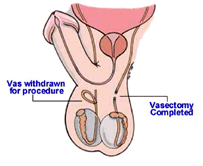Vasectomy is a surgical technique used to cut off and close the tubes, also called vasa deferentia, which connect the testicles and penis and carry the sperm, mainly produced by the testicles. The procedure is a permanent male contraceptive method , although vasectomy reversal is possible. However, some sources report that 60% of all vasectomy reversal procedures are inefficient. Others claim that new reverse vasectomy techniques have the efficiency of 99% in regaining fertility in male individuals, who have sperm at the time of the procedure.
How it works?
 It is important to understand the anatomy and functions of a male reproductive system in order to understand the main principle of vasectomy and how it works. Testicles that produce sperm and testosterone are located in the sack, called the scrotum, at the base of the penis. Testes are connected to epididymis — a small tube, where the sperm are kept for 6 weeks while they get mature. These tubes are linked to the prostate gland through vasa deferentia. The prostate produces seminal fluid. The sperm from the testicles and seminal fluid from the prostate gland are mixed during ejaculation to form semen.
It is important to understand the anatomy and functions of a male reproductive system in order to understand the main principle of vasectomy and how it works. Testicles that produce sperm and testosterone are located in the sack, called the scrotum, at the base of the penis. Testes are connected to epididymis — a small tube, where the sperm are kept for 6 weeks while they get mature. These tubes are linked to the prostate gland through vasa deferentia. The prostate produces seminal fluid. The sperm from the testicles and seminal fluid from the prostate gland are mixed during ejaculation to form semen.
During the vasectomy procedure vasa deferentia are sealed off and the sperm therefore cannot mix with the seminal fluid to form semen. A man is still able to ejaculate and reach orgasms. He also produces the same amounts of semen (fluid) when he ejaculates. The only difference is that there is no sperm present in the semen. A male body still produces the sperm after vasectomy but since they cannot mix with the seminal fluid, the sperm are basically reabsorbed by the body. Note that the procedure does not affect a man’s sex drive and libido, as it also does not interfere with the ability to perform and enjoy sex.
The Surgical Procedure
Vasectomy is usually performed in an out-patient department, therefore, no overnight stay in the hospital is needed. It usually takes about half an hour for the surgery to be over under local anesthesia.
A patient is asked to take a shower and wash the scrotum properly on the day of the surgical procedure. He is also asked to bring tight underpants that will be worn after surgery to support the testicles and reduce swelling. Your scrotum will be shaved prior to surgery so that no hair would get into the wound. Some male individuals prefer to do it themselves at home and may do so on the day of the surgery.
Before the procedure local anesthetics are injected in several places of the scrotum, which then numbs for the time of the surgery. The surgeon then finds the vas deferens under the skin and makes a small incision of about 1 cm on the scrotum. The tubes are then revealed and pulled out and cut in two places. The doctor takes a small segment of the vas deferens and then the ends of it are sealed off. The tubes can then be replaced back to the scrotum and the incision is sutured. The procedure is then carried out on the other side of the scrotum.
As an alternative to that is a so called no-scalpel procedure, during which a puncture incision is made instead of a cut. The surgeon uses special forceps to take the tube out, cut and cauterize.
Another alternative is placing a so called vasclip around the tube without any cut and suture.